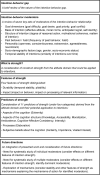Understanding the intention-behavior gap: The role of intention strength
- PMID: 35992469
- PMCID: PMC9386038
- DOI: 10.3389/fpsyg.2022.923464
Understanding the intention-behavior gap: The role of intention strength
Abstract
This manuscript overviews recent research on the intention-behavior gap, focusing on moderators of the intention-behavior relationship. The manuscript draws on the concept of intention strength to make two important points. First, strong intentions provide better predictions of behavior, thereby reducing the intention-behavior gap. However, strong intentions have the additional features of being more stable over time, less pliable in the face of interventions to change them, and more likely to bias information processing about engaging in the behavior. These four features of intention strength are not independent. For example, stable intentions are likely to provide better predictions of behavior. Second, various predictors of strength (e.g., importance, certainty, extremity) may also constitute important, but little studied, moderators of the intention-behavior relationship. Moreover, the effects of these moderators of the intention-behavior relationship may be mediated through intention stability (and perhaps other features of intention strength). Future research on the intention-behavior gap would benefit from a more systematic consideration of a broad range of moderators of the intention-behavior relationship both individually and in combination. In addition, future research could usefully explore how these moderating effects might be explained. Such a systematic approach may further our understanding of the intention-behavior gap in relation to physical activity and other behaviors.
Keywords: attitude strength; health behavior; intention; intention stability; intention strength; intention-behavior gap; physical activity.
Copyright © 2022 Conner and Norman.
Conflict of interest statement
The authors declare that the research was conducted in the absence of any commercial or financial relationships that could be construed as a potential conflict of interest.
Figures
References
-
- Abelson R. P. (1995). “Attitude extremity,” in Attitude Strength: Antecedents and Consequences, eds Petty R. E., Krosnick J. A. (Mahwah, NJ: Erlbaum; ), 25–41.
-
- Ajzen I. (1991). The theory of planned behavior. Organ. Behav. Hum. Decis. Process. 50 179–211. 10.1016/0749-5978(91)90020-T - DOI
-
- Armitage C. J., Conner M. (2001). Efficacy of the theory of planned behaviour: a meta-analytic review. Br. J. Soc. Psychol. 40 471–499. - PubMed
-
- Armitage C. J., Conner M. (2004). “The effects of attitudinal ambivalence on attitude-intention-behaviour relations,” in Theoretical Perspectives on Attitudes for the 21st Century: The Gregynog Symposium, eds Maio G. R., Haddock G. (Hove: Psychology Press; ), 121–143.
Publication types
LinkOut - more resources
Full Text Sources
Miscellaneous


